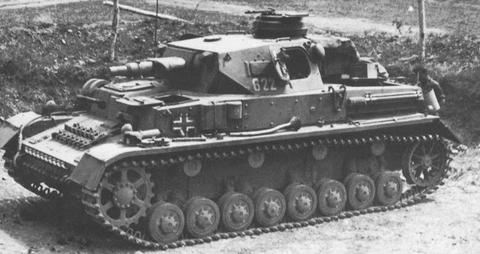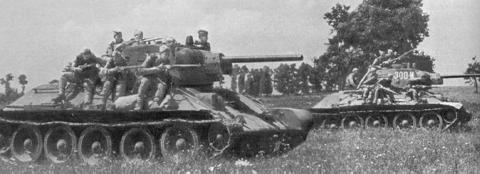Operation Barbarossa's Best Tank


We have a new poll up. For those of you who have read my book it is no mystery that armored warfare is by far my favorite aspect of the Second World War. In particular, my research and interests are overwhelmingly directed at the great armored clashes of the German-Soviet 1941-1945 war. As such, I am looking forward to your responses to our new poll question.
There were obviously a number of different tank models deployed by the Red Army and Wehrmacht during Nazi Germany's June 1941 invasion of the Soviet Union; named Operation Barbarossa. In an attempt to whittle the number of such AFV's down I have artificially limited your choices. For example, because the Panzer III Ausf J did not participate in Barbarossa's first three months it is not listed even though it equipped the 2nd and 5th Panzer Divisions sent to Germany's Eastern Front in September of 1941 (to bolster Army Group Center's Operation Typhoon). In addition, even though the T-34 and KV-1 were far outnumbered in the Red Army's ranks by earlier model BT-series tanks, there were enough of these newer tanks present from Barbarossa's first days, well over 1,000, to include them in this survey.
Now, the choices listed in the related poll found on the home page are also selected for a reason. Quite simply they go to the heart of what you consider to be the primary determinants of measuring a successful tank design. For instance if you are someone who believes that comparing the respective primary armaments and armored protection of competing tank designs serves as the clearest path to delineating the best then I believe your choices will be obvious. Conversely, if you tend to look at other elements beyond the "big two" of guns and steel, qualities that tend to determine which tank is best suited to helping its crew identify, target, and hit its foe before it can be targeted in turn - then your choices should also be obvious. The bottom line here is that there remains an enduring debate as to what elements really produce a successful tank design.
With that said let's briefly examine the contender's as listed in our poll:
Processing information in a timely fashion is a key element in finding success on the battlefield. What both the Panzer III Ausf H and Panzer Ausf E (top picture) did particularly well was embody this belief through the liberal use of radios. This allowed for vastly superior command and control over their opponents. Thus panzer commanders could react fluidly and quickly to battlefield developments. In addition, commander’s cupolas and superb optics were also standard on both of these tanks. All of this exponentially increased the operational tempo of German armored units. Tank designs such as these helped the German army concentrate firepower from numerous vehicles working in concert to defeat their foes. In addition, both the Panzer III Ausf H and Panzer IV Ausf E had plenty of room in their turrets for the tank’s commander, gunner, and loader. This freed up German tank commanders to not only communicate with their peers and coordinate their efforts; but also created a potent first hit capability.
As for armament and armored protection the Panzer III Ausf H had been upgraded over earlier models. To that end it featured a 50mm L/42 gun that could penetrate at standard combat ranges the majority of the Soviet tank armor encountered on Barbarossa’s battlefields. Panzer III Ausf H and Panzer IV Ausf E armor thickness also had been increased over earlier models mostly by adding 30mm armor plates. In the case of the Panzer III Ausf H the Germans added to the hull rear, hull front, and superstructure front; giving the tank 60mm of armored protection on these critical areas.
As for the Panzer IV Ausf E it came with 50mm thick armor on the hull front, with 30mm plate bolted to the superstructure creating 60mm total thickness therein, and 20mm plates bolted to the sides of the tank creating 40mm thick armored protection. The Panzer IV meanwhile represented the only tank Germany possessed in 1941 able to accommodate the necessary armament for handling the Red Army’s T-34s and KV-1s. Nevertheless the Panzer IV Ausf E did not have this armament during Barbarossa. Instead it was equipped with a 75mm L/24 main gun that was superb for destroying soft targets, but only mediocre in terms of effectively engaging the Red Army’s best protected tanks at standard combat ranges. What’s more, the additional armor plated onto two tanks that had been designed as lighter vehicles meant more work for German mechanics and logisticians; as such weight caused greater engine strain and higher fuel consumption. Over one third the German army’s tanks on July 1, 1941 were Panzer IIIs; comprising 327 of the early model 37mm gun armed Panzer IIIs and 1174 Panzer IIIs with the L/42 50mm guns. In addition the German army had just over 500 operational Panzer IV’s in its ranks. But not all of these Panzer III and IV’s were in Eastern Europe. Many were serving with occupation forces in Western Europe or in North Africa.
As for the Red Army Mikhail I. Koshkin’s Model 1941 T-34 medium tank (bottom picture) enjoyed tremendous advantages in armored protection and armament over both the Panzer III Ausf H and Panzer IV Ausf E. The T-34’s 76.2mm F-34 gun was much more powerful than any German tank gun fielded during Operation Barbarossa. It could not only defeat German tank armor at standard combat ranges, but also penetrate German armor at stand-off combat ranges reaching 1,000 plus yards. This meant that a T-34’s gun could penetrate German tank armor from distances beyond which the Russian tank could not be defeated in turn.
Although the T-34s frontal armor was of a comparable thickness to the Panzer III Ausf H and Panzer IV Ausf E it was sloped; and thus much more capable of stopping enemy tank rounds. In addition, the T-34’s diesel engine provided range, reliability, and power besting either German medium tank. From there the T-34 had far better cross-country mobility provided by its wide track and low ground pressure; therefore allowing the tank to cross ground that would otherwise cause the German tanks to bog down.
Unfortunately the T-34s two-man turret and lack of a commander’s cupola limited the Russian tank crew’s ability to target and engage opponents. In addition, the standard T-34 came without a radio, except in commander’s tanks. This made it nearly impossible for multi-tasking four man T-34 crews to coordinate in combat. The T-34 also possessed inadequate optics, therefore mitigating some of the advantages provided by the T-34’s powerful gun and protection. In addition, the T-34’s transmission failed to pace its dependable diesel engine. Moreover, the diesel engines, though reliable, had the propensity to overheat if not handled properly.
For its part, the heavy KV-1 series tank enjoyed not only an equally potent 76mm main gun but even better armored protection than did the T-34. I debated about including the KV-1 in this poll; mostly because it was a heavy tank with armored protection such that nothing short of a German 88mm anti-aircraft gun could reliably penetrate it. But size comes with a price. The KV-1 was slow and heavy, at times operating more as a mobile pillbox than anything else. So what would you want to be in if you were a tank commander on a fluid fast moving battlefield? Would you want to lead a battalion of mobile medium tanks or be able to deploy a few well protected heavy tanks? To that end there were roughly equal numbers of KV-1’s/T-34’s to Panzer III/Panzer IV’s opposing each other on Barbarossa’s first days (with the Red Army deploying 1,475 of the new heavy KV-1 and medium T-34 tanks near the Soviet Union’s western borders in 1941).
So which tank would you say was the best that fought during the entirety of Operation Barbarossa? Vote at the poll found on our homepage, and check back every so often to see how your tank is doing.



Post new comment